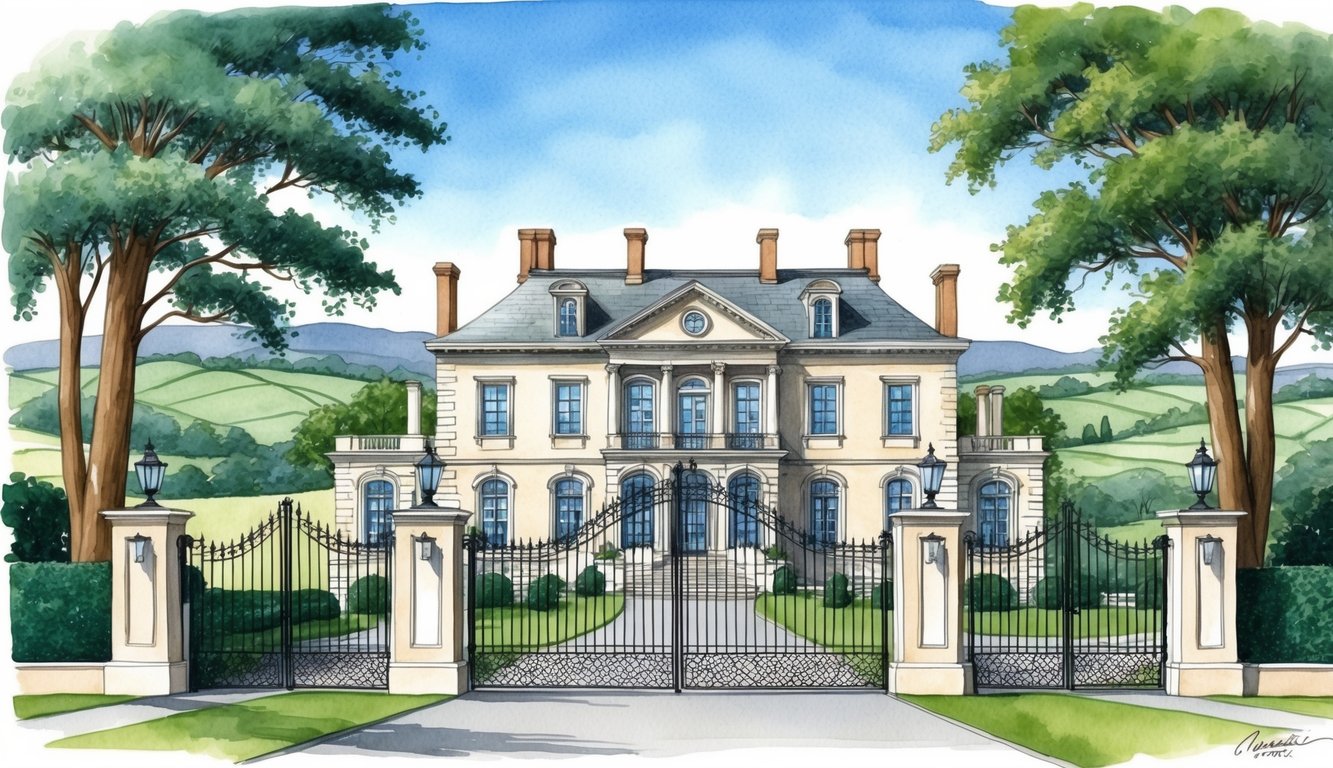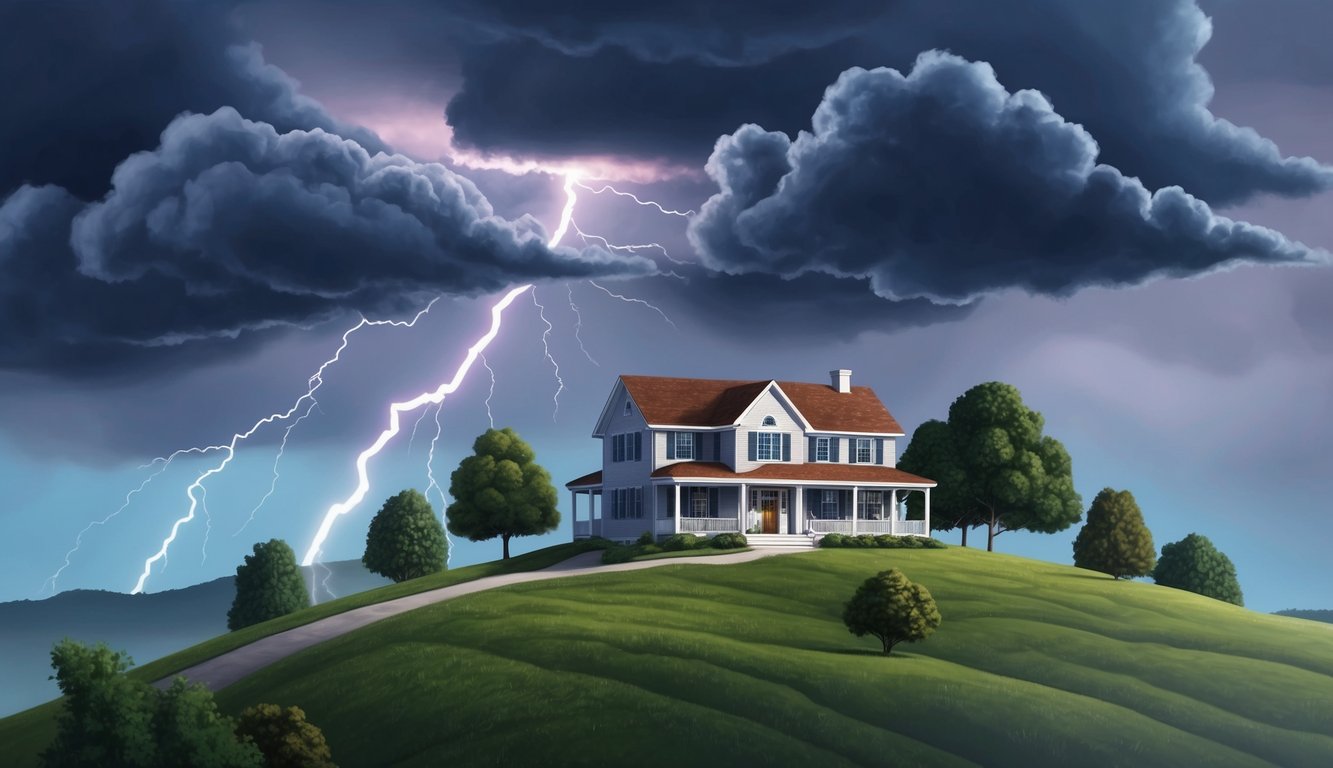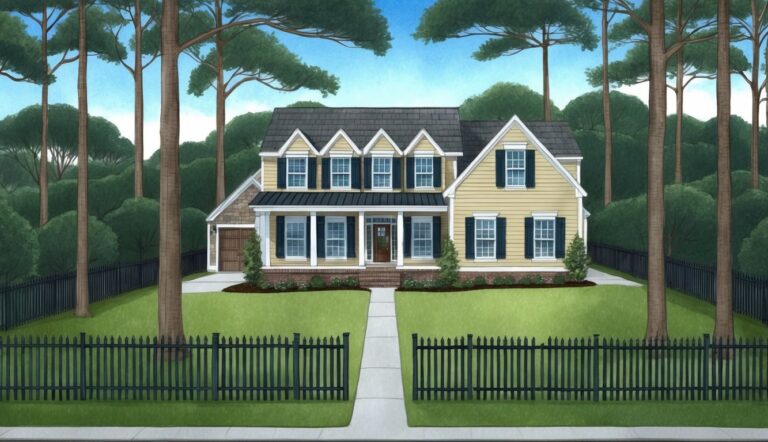Owning a high-risk property can make finding suitable homeowners insurance challenging.
Whether your home is in a disaster-prone area or has unique structural features, insurers may consider it riskier to cover.
This can lead to higher premiums or difficulty obtaining coverage altogether.
Several insurance companies specialize in providing coverage for high-risk properties.
These insurers understand the unique challenges associated with insuring homes that standard carriers might deem too risky. By exploring these specialized options, you can find comprehensive coverage that protects your investment and gives you peace of mind.
1) State Farm Premier Home Policy

State Farm offers a comprehensive Premier Home Policy designed for high-risk properties.
This plan provides extensive coverage options to protect your valuable assets.
The Premier Home Policy includes higher coverage limits for dwelling and personal property.
You’ll have peace of mind knowing your home and belongings are well-protected, even in high-risk areas.
State Farm’s policy offers extended replacement cost coverage.
If rebuilding costs exceed your policy limits, you may receive additional funds to restore your home to its original condition.
You can customize your policy with additional endorsements.
These may include coverage for water backup, identity theft, and high-value items like jewelry or artwork.
State Farm’s Premier Home Policy also includes increased liability protection.
This is particularly beneficial if you own a high-value property or have significant assets to protect.
The policy typically covers a wide range of perils, including fire, wind, hail, and theft. State Farm is often considered one of the best options for comprehensive coverage in high-risk situations.
You may be eligible for discounts by bundling your home and auto insurance or installing safety devices.
These can help offset the potentially higher premiums associated with insuring a high-risk property.
State Farm provides excellent customer service and a user-friendly claims process.
Their mobile app allows you to easily manage your policy and file claims when needed.
2) Allstate High-Value Home Insurance

Allstate offers specialized coverage for high-value homes, catering to properties that may be considered high-risk.
Their policies are designed to provide comprehensive protection for luxury homes and valuable assets.
You can expect higher coverage limits with Allstate’s high-value home insurance.
This is crucial for homes with expensive materials, custom features, or unique architectural designs that may cost more to rebuild or repair.
Allstate provides extended dwelling coverage for high-value homes.
This means if your home’s rebuilding cost exceeds your policy limit, you’re still protected up to a certain percentage above that limit.
Your valuable possessions receive enhanced protection with Allstate.
They offer higher limits for personal property coverage, ensuring your expensive items like jewelry, art, or collectibles are adequately insured.
Allstate’s high-value policies often include additional living expenses coverage.
If your home becomes uninhabitable due to a covered loss, you’ll be reimbursed for temporary housing costs that match your standard of living.
You can benefit from Allstate’s risk management services.
They may offer consultations to help you identify and mitigate potential risks to your high-value property, potentially reducing the likelihood of future claims.
Allstate provides personalized service for high-value homeowners.
You’ll typically work with a dedicated agent who understands the unique needs of luxury properties and can tailor your coverage accordingly.
3) Nationwide Private Client Program
Nationwide’s Private Client Program offers specialized insurance solutions for high-value homes and high-net-worth individuals.
This program provides exceptional coverage tailored to meet the unique needs of affluent homeowners.
Coverage crafted for changing needs is a hallmark of the Private Client Program.
It adapts to your evolving lifestyle and the rapid changes in the world around you.
The program’s homeowners policies include several premium features.
You’ll benefit from agreed replacement cost coverage, which ensures your home can be rebuilt to its original specifications, even if the cost exceeds your policy limit.
A replacement cash-out option is available in case of total loss.
This allows you to decide whether to rebuild or receive a cash settlement, giving you flexibility in your recovery process.
The Private Client Program extends beyond standard homeowners insurance.
It encompasses a range of protection options for your valuable possessions, vehicles, and personal liability.
You’ll work with dedicated risk solutions advisors who understand the complexities of insuring high-value properties.
These professionals can help you identify potential risks and develop comprehensive protection strategies.
Nationwide’s program also offers personalized claim services.
In the event of a loss, you’ll have access to specialized adjusters who are experienced in handling high-value claims efficiently and discreetly.
4) Chubb Masterpiece Homeowners Insurance

Chubb offers a premium homeowners insurance option called Masterpiece, designed for high-value and high-risk properties.
This policy provides comprehensive coverage that goes beyond standard home insurance plans.
With Chubb Masterpiece, you get extended replacement cost coverage for your home.
This means if rebuilding costs exceed your policy limit, Chubb will pay the full amount to restore your home to its original condition.
The policy includes generous coverage for your personal belongings.
Unlike many insurers, Chubb allows you to choose between cash settlement and replacement for damaged items.
Chubb Masterpiece also offers enhanced protection for trees, shrubs, and plants.
You can receive up to $10,000 for any single plant, significantly more than standard policies typically provide.
For high-risk properties, Chubb’s risk consulting services are particularly valuable.
They offer personalized advice to help you protect your home from potential hazards.
If you own multiple homes or valuable collections, Chubb Masterpiece can provide seamless coverage across all your properties and possessions.
This simplifies your insurance management and ensures comprehensive protection.
While Chubb Masterpiece tends to be more expensive than standard policies, it offers peace of mind for owners of high-value or high-risk properties.
The extensive coverage and personalized service can make it a worthwhile investment for protecting your valuable assets.
5) AIG Private Client Group

AIG Private Client Group specializes in high-value and historic homes.
If you own a luxury property or a home with unique features, this insurance provider might be the right choice for you.
The company offers comprehensive coverage options tailored to meet the needs of high-net-worth individuals.
You can expect a range of premier coverages included in their base policy.
Guaranteed replacement cost coverage is one of the standout features.
This ensures that your home will be rebuilt to its original specifications, even if the cost exceeds your policy limits.
AIG also provides water backup coverage as standard.
This protects you from damages caused by sewer or drain backups, which can be particularly costly in high-value homes.
You’ll benefit from increased blanket personal property coverage.
This allows for greater protection of your valuable possessions without the need to schedule each item individually.
The average policyholder pays around $18,000 in annual premiums.
While this may seem high, it reflects the comprehensive nature of the coverage and the high-value properties insured.
AIG’s focus on risk management sets it apart.
They offer services to help you protect your property and prevent losses before they occur.
If you’re looking for insurance that goes beyond standard coverage and caters to luxury properties, AIG Private Client Group could be an excellent choice for your high-risk home.
6) Liberty Mutual High-Risk Coverage

Liberty Mutual offers high-risk homeowners insurance that can provide coverage for properties that may be difficult to insure.
If you’re struggling to find coverage for your high-risk home, Liberty Mutual might be a suitable option.
The company provides coverage for various high-risk factors, including homes in areas prone to natural disasters.
You may be able to secure a policy if your property is located in a region susceptible to hurricanes, floods, or wildfires.
Liberty Mutual also considers insuring homes with older roofs or outdated electrical systems.
These features often make it challenging to obtain coverage from other insurers, but Liberty Mutual may be more flexible.
If you have a history of multiple claims, Liberty Mutual might still offer you coverage.
While your premiums may be higher, you’re not automatically disqualified from obtaining a policy.
The insurer provides customizable coverage options, allowing you to tailor your policy to your specific needs.
You can add endorsements or riders to enhance your protection for high-risk scenarios.
Liberty Mutual offers a range of discounts that can help offset the higher costs associated with high-risk coverage.
You may qualify for savings based on factors such as home safety features, bundling policies, or maintaining a claim-free record.
When considering Liberty Mutual for high-risk coverage, it’s essential to compare quotes and policy details with other insurers.
This approach ensures you find the most suitable and cost-effective coverage for your unique situation.
7) USAA High-Risk Home Insurance
USAA offers specialized insurance options for high-risk properties.
If you’re a military member or from a military family, USAA home insurance could be an excellent choice for your high-risk property needs.
USAA provides high-value home insurance for luxury homes with custom or unique features.
This coverage extends beyond standard homeowners policies, offering additional protection for personal items like fine jewelry.
For homeowners in wildfire-prone areas, USAA offers a unique Wildfire Response program.
If you live in a covered state and have an active USAA policy, you’ll be automatically enrolled at no extra cost.
The program monitors for wildfire threats and can dispatch certified firefighters to help prevent losses.
This proactive approach sets USAA apart in high-risk home insurance.
USAA’s policies typically cover the dwelling, other structures like pools and fences, and personal property.
Their coverage is comprehensive, addressing many of the concerns associated with high-risk properties.
While USAA’s services are limited to military members and their families, they consistently receive high marks for customer satisfaction.
Their expertise in serving this demographic makes them a strong contender for high-risk home insurance.
8) Farmers Smart Plan Home
Farmers Insurance offers a customizable home insurance option called Smart Plan Home.
This plan provides flexibility for high-risk properties.
You can tailor coverage to your specific needs.
Smart Plan Home comes in three customizable packages as a starting point.
You can choose the level of coverage that best suits your high-risk property.
The plan includes standard coverages like dwelling protection, personal property, and liability.
Beyond these basics, you can add various options to enhance your policy.
Popular features offered by Farmers include additional coverage for high-value items, identity theft protection, and eco-rebuild options.
These can be particularly useful for high-risk properties.
Farmers also provides options for vacant homes, which can be considered high-risk.
This coverage can protect your property even when it’s unoccupied for extended periods.
While Farmers offers comprehensive options, it’s important to note that rates may vary.
You might want to compare quotes from multiple companies to ensure you’re getting the best deal for your high-risk property.
Remember to discuss your specific situation with a Farmers agent.
They can help you navigate the available options and create a policy that addresses the unique risks associated with your property.
9) Pure Insurance Custom Coverage

Pure Insurance offers tailored coverage options for high-risk properties.
Their high-value homeowners policy includes comprehensive protection for jewelry up to $50,000, safeguarding your valuable items against loss, misplacement, or theft.
Pure Insurance stands out with its 5-star coverage for high-value homes.
You can expect a wide array of policy add-ons and complimentary mitigation services to ensure your property is fully protected.
The company’s custom coverage extends beyond standard policies.
You can tailor your insurance to address specific risks associated with your high-value or historic home.
This flexibility allows you to create a policy that precisely fits your unique needs.
Pure Insurance excels in providing specialized coverage for luxury properties.
Their policies can include protection for fine art, wine collections, and other high-value items that may require additional coverage beyond standard homeowners insurance.
With Pure Insurance, you’ll benefit from personalized risk management services.
Their experts can assess your property and recommend preventive measures to reduce potential risks, helping you maintain lower premiums in the long run.
10) American Family Premier Home Insurance
American Family Insurance offers a Premier Home Insurance plan that can be suitable for high-risk properties.
This plan provides comprehensive coverage with enhanced features beyond standard policies.
The Premier Home Insurance includes higher coverage limits for personal property and liability protection.
You’ll benefit from additional protection for valuable items like jewelry, art, and collectibles.
One standout feature is the guaranteed replacement cost coverage.
This ensures your home will be rebuilt to its original quality, even if costs exceed your policy limits.
American Family’s Premier plan also offers extended coverage for water damage, including backup of sewers and drains.
This can be particularly valuable for high-risk homes in flood-prone areas.
You’ll have access to a personal insurance review every year.
This helps ensure your coverage keeps pace with any changes to your property or personal circumstances.
The company provides a network of local agents who can offer personalized service.
They can help you understand the specific risks associated with your property and tailor your coverage accordingly.
American Family Insurance offers various discounts that can help offset the higher premiums often associated with high-risk properties.
These may include multi-policy, loyalty, and safety device discounts.
Understanding High-Risk Properties
High-risk properties face unique challenges when it comes to insurance coverage.
These properties require special consideration due to their increased likelihood of claims or potential for significant losses.
What Qualifies as High-Risk?
Properties may be considered high-risk for various reasons.
Your home could be classified as high-risk if it’s located in an area prone to natural disasters like hurricanes, floods, or wildfires.
Older homes or those with outdated electrical, plumbing, or heating systems may also fall into this category.
Vacant properties or those used for short-term rentals often qualify as high-risk.
If you have a history of multiple insurance claims or poor credit, insurers may view your property as high-risk regardless of its physical characteristics.
Homes with certain features like swimming pools, trampolines, or aggressive dog breeds can also increase risk levels.
Factors Influencing Risk Levels
Several factors can influence your property’s risk level in the eyes of insurance companies:
- Location: Proximity to fire stations, coastlines, or flood-prone areas
- Construction materials: Wood-frame vs. brick or concrete
- Age of the home: Older homes may have outdated systems or structural issues
- Roof condition: Age and material of your roof
- Security features: Presence of alarm systems, smoke detectors, or sprinklers
Your personal factors also play a role. Your credit score, claims history, and even occupation can impact risk assessment.
Insurance companies use complex algorithms to evaluate these factors.
Understanding them can help you take steps to mitigate risks and potentially reduce your insurance costs.
Coverage Options for High-Risk Properties
High-risk properties require specialized insurance plans to address unique risks.
You’ll need to understand the differences between standard and specialized coverage, as well as additional considerations for comprehensive protection.
Standard vs. Specialized Insurance Plans
Standard homeowners insurance may not sufficiently cover high-risk properties.
You’ll likely need a specialized plan tailored to your specific risks.
These plans often include higher coverage limits and protection against perils that standard policies exclude.
High-risk homeowners insurance can cover homes with multiple claims, poor credit scores, or located in disaster-prone areas.
Some insurers offer policies specifically for vacant homes or high-value properties.
If you’re struggling to find coverage, look into state-run FAIR plans.
These programs provide insurance options for high-risk properties when private insurers won’t.
Additional Coverage Considerations
For comprehensive protection, consider adding endorsements to your policy.
These can include:
- Extended replacement cost coverage
- Flood insurance (often required in high-risk flood zones)
- Earthquake coverage in seismically active areas
- Windstorm protection for coastal properties
You might also need increased liability coverage, especially for high-value homes.
Some insurers, like AIG, specialize in coverage for luxury or historic properties.
Review your policy limits regularly to ensure they keep pace with rising construction costs and property values.
This helps avoid underinsurance in case of a total loss.
Tips for Reducing Home Insurance Costs
Raising your deductible is an effective way to lower your premium.
By increasing your deductible from $500 to $1,000, you could potentially save up to 25% on your insurance costs.
Improving your credit score can also help reduce your premiums.
Many insurers consider credit history when determining rates, so maintaining good credit can lead to lower costs.
Bundle your home and auto insurance policies with the same company.
This often results in discounts on both policies.
Install security devices like smoke detectors, burglar alarms, and deadbolt locks.
These improvements can make your home safer and may qualify you for discounts.
Consider upgrading your roof or reinforcing it against weather damage.
Homes with newer, more durable roofs often qualify for lower insurance rates.
Review your coverage annually and remove any unnecessary add-ons.
Ensure you’re not over-insuring your property or personal belongings.
Ask your insurer about available discounts.
You may qualify for savings based on factors like being claim-free for several years, living in a gated community, having a fire station nearby, or being a non-smoker.
Shop around and compare quotes from multiple insurers.
Rates can vary significantly between companies, so getting multiple quotes can help you find the best deal.






